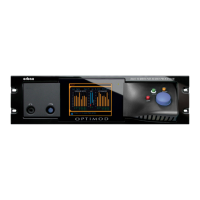1-4
INTRODUCTION ORBAN MODEL 8685
• While primarily oriented toward “flat” media, the 8685’s four 2.0 channel
processors can also provide preemphasis limiting for the two standard pre-
emphasis curves of 50μs and 75μs. This allows it to protect pre-emphasized ana-
log microwave links, satellite uplinks and similar channels where protection lim-
iting or light processing is required. It also allows using a 2.0 processor to process
for analog television transmissions, which use either 50μs and 75μs preem-
phasis depending on country.
Note that the 8685’s 2.0 channel processing cannot provide simultaneous,
independent audio processing for flat and preemphasized channels. Even
though one output may be pre-emphasized while other is flat, the only
difference between the outputs is that the “flat” output has de-emphasis
applied to it after the processing while the preemphasized output does
not.
Flexible Configuration
• Five processors in one: A gain-coupled multichannel processor for up to 7.1
channels, plus four additional, independent 2.0 channel processors (each of
whose performance is equivalent to an OPTIMOD 6300) that can be used for
many tasks such as processing the audio for a second language or for processing
up to four ATSC subchannels. Because its output can be mixed into the LF and RF
outputs of the multichannel processing, the first 2.0 channel processor can also
be used to process an independent feed (like the output of a sports truck,
news truck, or newsroom) before it is mixed with the station’s main multichan-
nel audio path.
• The multichannel and 2.0 processors can operate with separate audio proc-
essing parameters like release times. For example, the 2.0 processors could be
set up for relatively heavy processing to make a newsroom feed more consistent,
while the main processing was set up more conservatively to correct network
material and commercials unobtrusively.
• The base 8685 configuration includes five AESid digital inputs and six AES3id
outputs, all transformer-coupled. These inputs and outputs appear on BNC
connectors and have 75Ω impedance. The digital inputs and digital outputs have
sample-rate converters and can operate at 32 kHz, 44.1 kHz, 48, 88.2, and 96 kHz
sample rates.
• The optional HD-SDI I/O module includes three AES3id inputs and three
AES3id outputs, which can be used as a loop-through for Orban’s Penteo®
2.0Æ5.1 upmixer or to provide I/O for up to three channels of 2.0 processing.
The SDI I/O option provides up to 11 frames of video delay to match the delay
of the 8685’s loudness processing (typically 20 ms) and optional Dolby-E en-
code and decode. A relay provides hard-wire safety bypass from the SDI in-
put to the SDI output in case of hardware failure. (See Optional HD-SDI In-
put/Output Interface Module on page 6-3 for details.)

